Codeless Test Automation for Modern Web Apps: A Full Guide
Delve into the guide to learn about automation test for modern web app and trends in software testing. Find out how codeless automation testing will give your business new life.

IT specialists keep indulging us with such sophisticated user experiences that a picky user can’t but lodge themselves inside every one of us. Your client is no exception. For this reason, we feel it necessary to create this automation testing guide to help you wrap your head around automation test for modern web apps and understand how codeless automation tools are of so much importance for the growth of your business.
In this market guide for web app test automation tools, we will also cover some of the emerging test automation trends and shed light on some of the next generation software automation testing tools. But first, let’s find out what automation testing actually is.
Advanced Automation Testing of Modern Apps
Companies are prioritizing moving from manual to automated testing as quickly as possible and that’s why moving to automated testing is the top priority around software testing (30% of companies mentioned it as the top priority according to these research results). Respondents believe that automation testing is driving business innovation, while manual testing remains one of the major roadblocks to success.
Another study found that manual testing takes 160 hours for a thousand full regression test cases, while automation tests will take 16 hours for the same number of cases.
These numbers represent that manual testing increases working hours tenfold. It’s no wonder that businesses, where manual testing will prevail, are doomed. So to start the guide to automation testing, let’s brush up on some automated testing basics.
In essence, automation testing was created in order for QA engineers not to get bogged down by monotonous work. At the same time, automation tests minimize the chances of fallacy, which all human beings are prone to, especially when they do something repetitive. It usually works like this: a QA engineer writes initial test cases, then a special automated test tool runs these tests and compares the expected results with the results obtained.
Automated testing perfectly fits in with continuous integration and continuous delivery practices that aim at conducting all the stages of software development simultaneously. As required by DevOps culture, automated testing provides the opportunity to check every line of code before it is deployed to the main code base. Fast, effective, and precise. But we’ll talk about it a little bit further in this complete guide to test automation.
We should mention that the main disadvantage of test automation is that it demands a whole-scale development of a piece of software. Due to this, business owners should come to terms with the idea that this process is complicated and demands investment, both moral and financial. In this process, the importance of the right testing strategy can’t be overstated. And first, we need to choose the right framework.
Choosing the Right Automated Framework
There are several types of frameworks that feature reusable components to reduce the burden of writing test scripts from scratch. Frameworks include test libraries, reusable tests and tools, and easy and clear reporting.
The demands of every enterprise are different. That’s why you need to ponder over a number of questions before opting for this or that framework. For example, ask yourself if you have a team of professional engineers or testers with only basic skills. Or what kind of reporting you want to receive from automation. If an app has a complex flow, and how much you’re ready to budget for this.
There are six main types of automation testing frameworks.
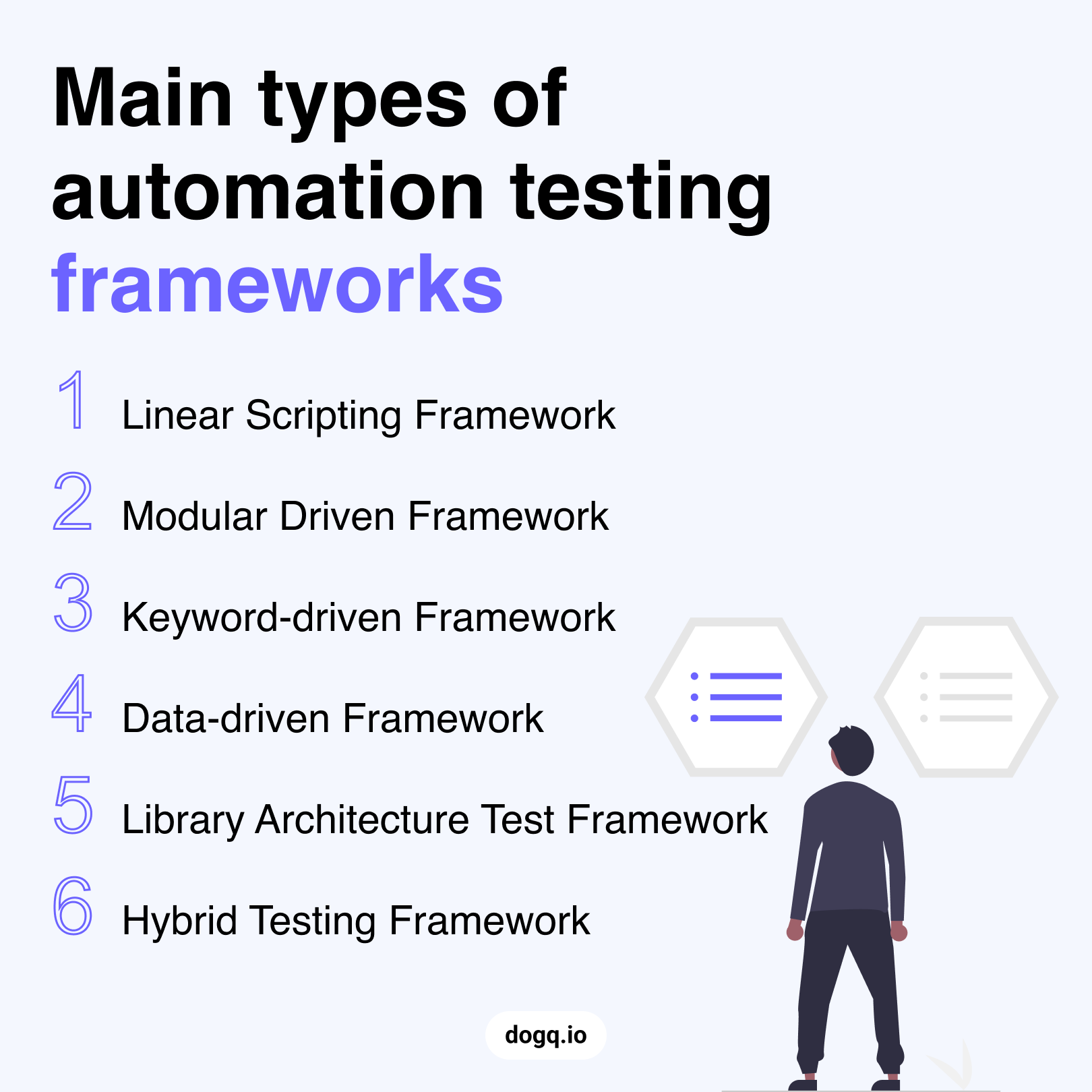
- Linear Scripting Framework. They’re often called “Record and Playback”. They create and execute tests and are suitable to linearly test small web apps. It’s easy to learn, as a tester just records their actions, and then the recorded tests are playbacked.
- Modular Driven Framework. Here, a tester divides an app into separate modules and creates test scripts for each of them. Such frameworks are very flexible and expandable. So changes can be introduced to one module and it won’t affect the others. Then, the test scripts of different modules are put together to build a larger test script.
- Keyword-driven Framework. This one is based on using keywords or action words for a method to be executed. It’s similar to Data-Driven Frameworks, but it demands less coding knowledge and is not dependent on a specific programming language. It allows all the team members to work collaboratively on testing without all the work being concentrated on the QA engineers alone. Thus, specific keywords are mapped to specific functions, and tests can be run by simply using keywords.
- Data-driven Framework. This framework requires coding skills and more comprehensive knowledge. It boils down to separating data, test scripts, and logic to store it in an external database. The test cases are easily modified, as test case data is segregated from the test script executed. Hence, modifying just one functionality of a test case is possible without the need to modify the code. It’s perfect for running tests using the same test script for several data sets.
- Library Architecture Test Framework. With the library architecture test platform, the framework identifies tasks holding similarities within the test script. After that, testers group similar tasks by function. The library then saves all sorted functions. Hence, it makes it easier to reuse the code in various test scenarios. This framework is useful when the application has similar functionality in different parts of the application.
- Hybrid Testing Framework. Some frameworks combine the previously mentioned frameworks, and they’re called Hybrid Frameworks. This approach allows testers to compensate for the downsides of one framework with the advantages of another one.
Automated Testing and the CI/CD Pipeline
The CI/CD pipeline is widely adopted by more and more businesses, with the rise of DevOps. The very concept of a CI/CD pipeline boils down to expediting the production process of an app by conducting all the development stages simultaneously. To put it simply, while one piece of code is being built, another one is being tested, and the other is being deployed. Doing work this way allows them to constantly receive feedback about code, prevent intrusion of the bugs into the main codebase in the early stages, and have wider test coverage.
Imagine that the step of testing in the CI/CD pipeline would be done only manually. Absurd, isn’t it? It wouldn’t provide the agility needed, hence this set of strategies wouldn’t become so widespread.
Is Automated Testing of Web Apps Different?
Testing of web apps is different from testing of mobile apps. Nevertheless, both of them serve the same goals, but they differ in terms of their architecture and delivery mechanism, which leads to a difference between testing web applications and mobile applications.
The difference between mobile app testing and web app testing is more noticeable in terms of user experience, internet connectivity, and compatibility. That’s why modern web apps require a number of additional types of testing.
Next Generation Software Testing
On the whole, the modern technology of automated testing is facilitated by artificial intelligence and machine learning. Leveraging these technologies in the world of software testing is claimed to be the most efficient.
One of the newest trends in software testing is using codeless test automation tools.
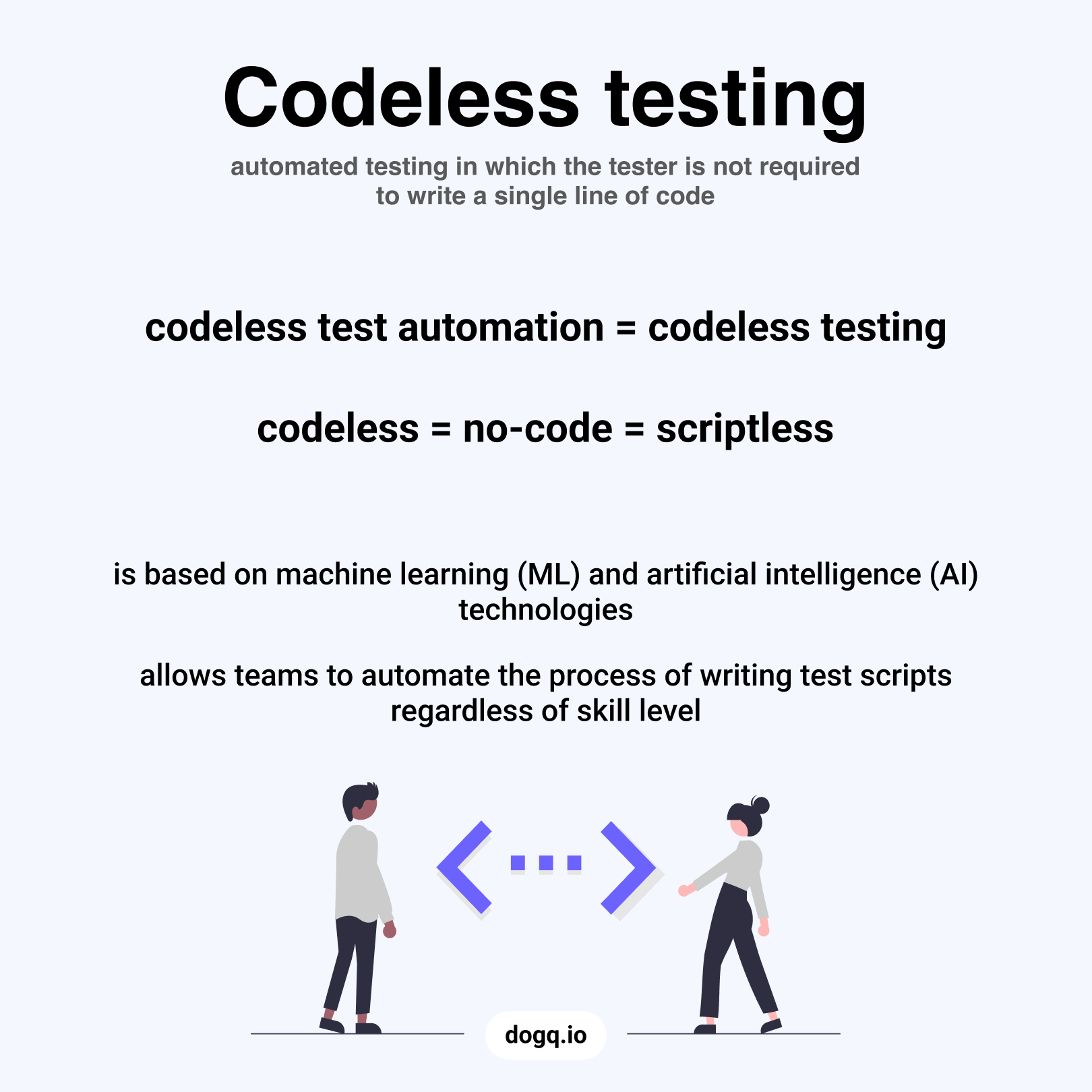
Codeless testing is the automated testing in which the tester is not required to write a single line of code, so codeless test automation is exactly the same process as codeless testing. Moreover, codeless, no-code, and scriptless testing are essentially the same thing.
Codeless automation allows teams to automate the process of writing test scripts regardless of skill level. And codeless test automation is also based on machine learning and AI technologies. While some have become ardent supporters of this new trend and have started to implement it in their businesses right away, others remain skeptical about it. At the end of this test automation guide, we want to discuss codeless test automation tools and explain why this type of testing is gaining more and more attention.
Codeless Automation: Another Marketing Ploy?
The prediction for codeless test automation is as follows: the codeless testing market is expected to increase at 15.5% CAGR from USD 1.5 billion in 2021 to USD 6.3 billion by 2026. According to these data, codeless market share in 2023/2022 is expected to be around 6.5%.
If it were of no use, codeless test automation tools wouldn’t have achieved so much popularity among businesses.
Codeless automated testing is gaining popularity as more and more companies are implementing DevOps and Agile methodologies that focus more on automation. Since codeless automated testing does not require special programming knowledge, it is becoming increasingly popular among organizations with limited resources.
The main reason for it is that the market lacks many QA engineers who can create the right test scripts for automation, and if a company were lucky enough to find them, they’d better concentrate on more complex tasks.
So codeless testing benefits companies of any size when it comes to saving money.
Still not convincing enough? Oh, you’re not willing to blindly follow somebody you don’t even know? Okay, then. We’d better explain how it works.
How Codeless Test Automation Tools Work
As was mentioned above, codeless test automation solutions cope with the coding load for organizations that cannot allocate additional resources for programming or support extensive maintenance of test scenarios. In a nutshell, just as the name implies, any user can just use codeless test automation tools and not write code.
It works like this: users simply interact with the codeless testing tool through the user interface to define and refine the testing steps, and then perform these tests. And codeless automated testing tools work on the cloud with cloud infrastructure.
And What Do I Get From Codeless Test Automation Tools?
The prior goal of any codeless automated testing tool is to make any non-technical specialist like business analyst, project manager, DevOps specialist, and even junior QA engineer able to create and run any test scenarios they need.
But what are the other advantages of codeless automation testing tools? We can enlist as many as 12 of them:
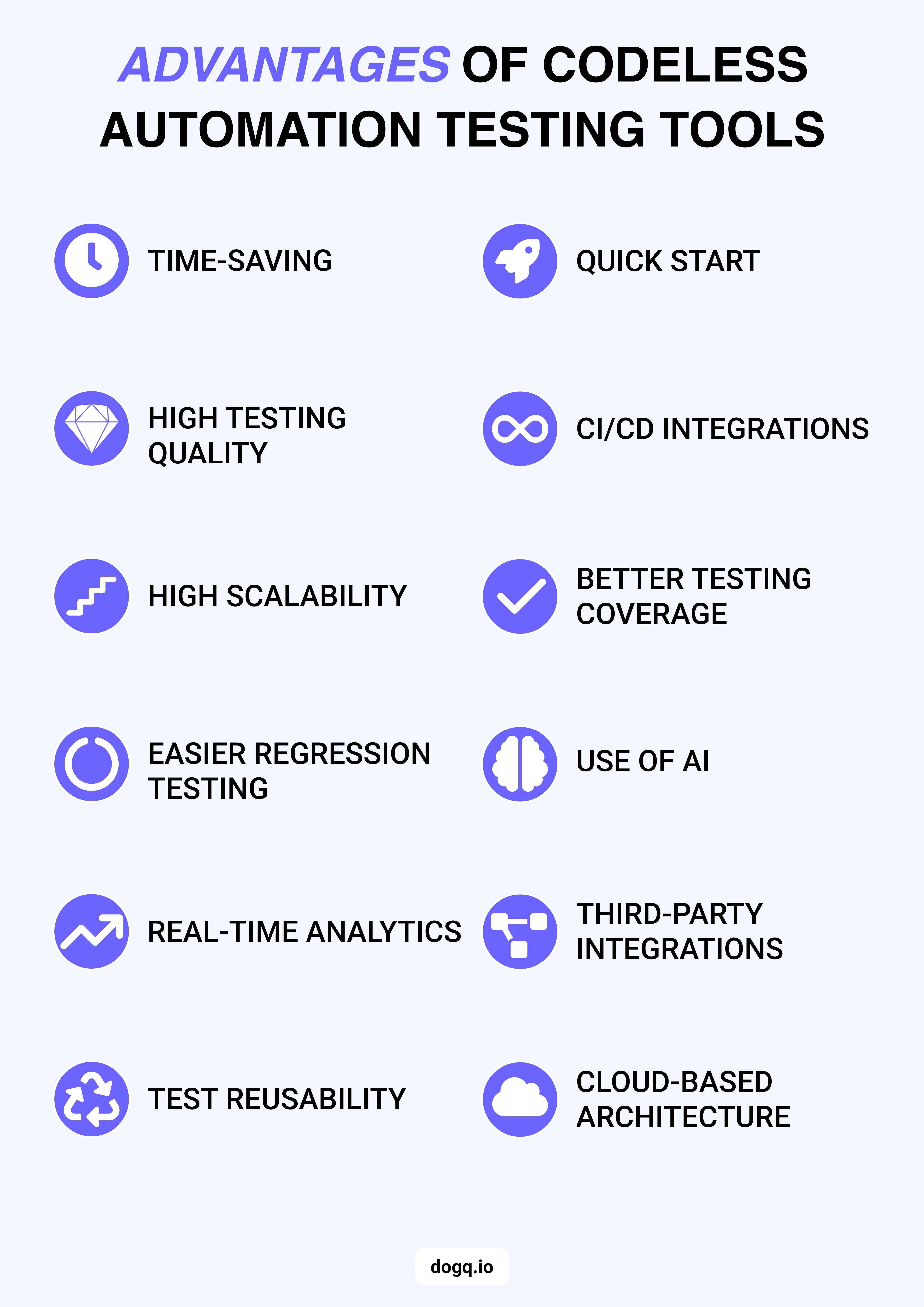
1. Time-saving;
2. Quick start;
3. High testing quality;
4. CI/CD integrations;
5. High scalability;
6. Better testing coverage;
7. Regression testing performed easier;.
8. Use of AI;
9. Real-time analytics;
10. Third-party integrations;
11. Test reusability;
12. Cloud-based architecture.
You also don’t need to outsource or increase a team of automation specialists, as using such tools is possible without extensive coding experience. These tools are user-friendly and provide users with documentation and tutorials, and most of the tools come together with a community of automation engineers to whom you can always reach out for help.
It’s a perfect solution for startups as the costs spent on codeless testing tool’s implementation are low. You only need to pay for the subscription for the tool’s maintenance.
What Kind of Tests Can I Automate Without Writing Code?
One of the essential parts of a good testing strategy for web apps is to determine what kinds of tests can be automated without the need to create scripts.
First come the tests that are repetitive and time-consuming, and we’re talking about them below. But priority should also be given to these tests, which are not only difficult to perform manually but also focus on the risk and money areas of an app.
If you want to become an automated testing geek, or you’re somewhere at the beginning of your journey, let’s peek together at some other testing points: tests that can be automated without coding.
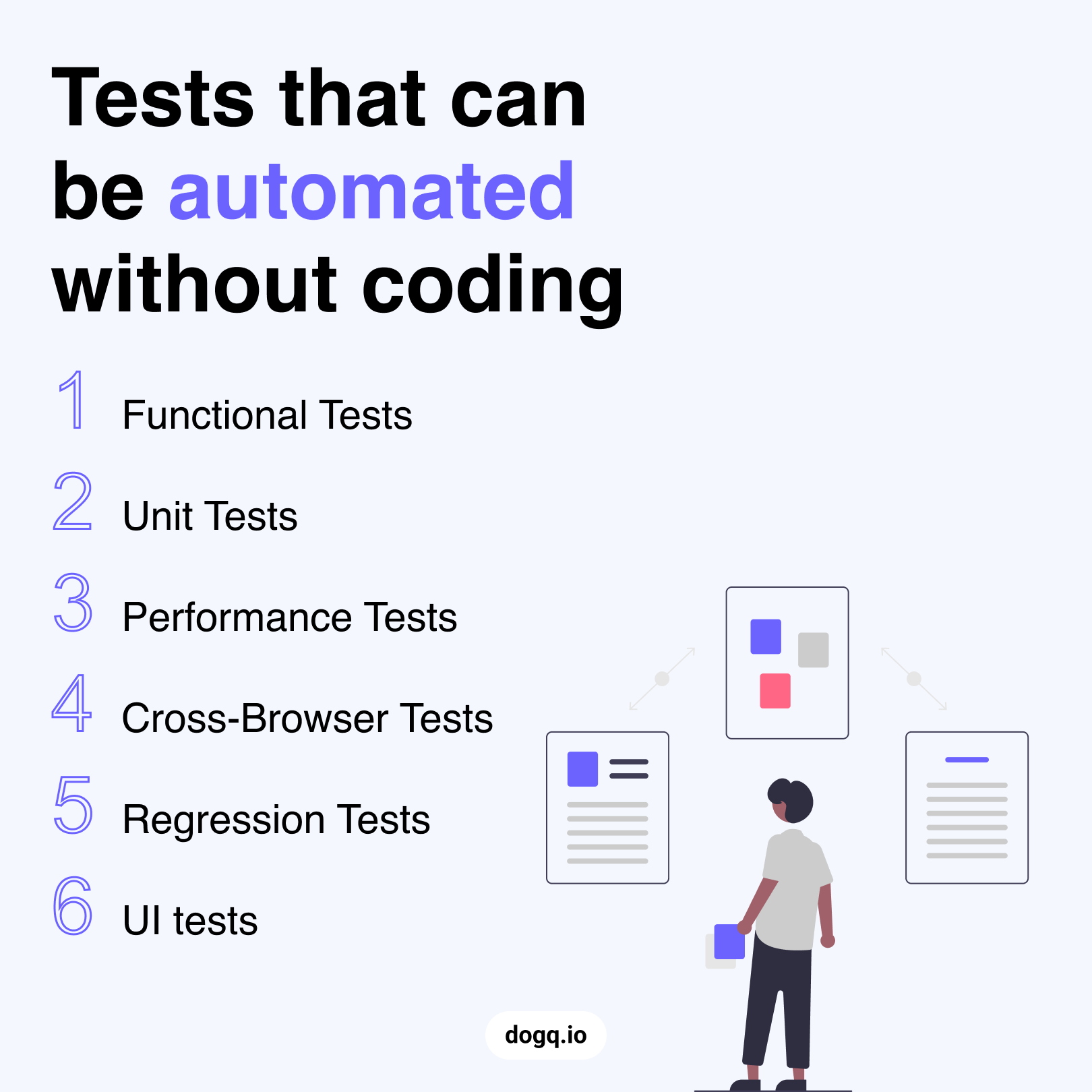
Functional and Unit Tests
Our decision to include these two types of tests in one paragraph of this guide to test automation is not fortuitous, as they’re often confused. The simplest real-life analogy of functional and unit tests is that of a house.
Functional testing can be compared to an inspector who comes to the house to make sure the foundation, electrical, and framing are correctly established in terms of a whole house system. A unit testing here is a homeowner, whose main concerns are whether the house is comfortable enough and what size and shape the rooms are, and if they fit the needs of their family.
Thus, functional tests are written from the perspective of a final user who wants the functionality to work smoothly and the system to do what they want it to. Unit tests are created from the perspective of a software engineer, who needs the code to be correct and do things right.
Functional tests are run to check if a whole app as a system will behave in the way developers expected it to, precisely whether the code is doing the things it’s prescribed to do. Unit tests check if different parts of the app system work correctly.
Performance Tests
Basically, its main aim is to determine whether a product works stable and if it’s responsive under various workloads and in different operating environments.
Cross-Browser Tests
So as not to take away the opportunity to use your app from Safari or Opera users, it’s important that it works properly on different browsers. Cross-Browser testing allows you to check if your web app is compatible with all devices and if a user can use the whole range of functionalities of an app, regardless of the type of browser they prefer.
Regression Tests
When a change is introduced to the code, it’s important to make sure that it doesn’t break the functionality that already exists and works properly. Regression tests are no different from unit or integration tests, so you can just rerun all the tests written from the very beginning to check that they’re not failing. Just as the name implies, this type of test’s primary task is to check that an app didn’t “regress” when even the tiniest change was introduced.
UI Tests
Today even UI tests can be performed by codeless automation technology, while several years ago it was claimed that UI tests can be done manually only. Day by day codelessly automated UI tests are becoming just as sophisticated as human assessments of the user interface. For this, we should praise artificial intelligence and machine learning technologies.
It checks the overall appearance of your web app, if all the visual elements are in the right places, and how appealing they look.
As you can see, it’s only natural that most of the tests can be performed via codeless automation. But pay attention to the word “most”, as not all of them can be automated.
Codeless Test Automation Myths
Here, we should mention that there are a lot of misconceptions surrounding the theme of software development. A huge chunk of them is about codeless automated testing. That’s why we will continue this automation testing tutorial by covering the main myths about codeless automated testing that scare many business owners away from implementing these tools.
Codeless Automated Testing Lacks Flexibility
If you think that you can’t edit a test case that was already created, it’s a myth. The codeless testing tools support easy editing and maintenance of test cases at any time. And several advanced codeless automation tools have the capabilities to be customized to add additional functionalities. You just need to choose the right tool that will fit your business goals.
Codeless Testing Is Not Truly Codeless
Codeless testing tools actually don’t make a user write a script. But a tool itself creates the code silently behind the scenes. The advanced technologies like AI and ML now enable tools to actually offer truly codeless testing solutions.
Codeless Automated Testing Is Expensive
Research shows that test automation has not only truly outstanding ROI, but also significant business and IT values. When dealing with codeless test automation, a huge price range is available to you, which includes not only expensive solutions but also programs at a very low cost.
Collaboration While Using Codeless Automated Testing Is Difficult
Modern codeless automation tools are cloud solutions. This means that all the tests that you create are stored directly in the cloud, you can easily grant access to other team members and sync your work.
Codeless Automated Testing Needs Zero Technical Skills
Knowledge on HTML, CSS may be required to execute some test cases successfully, but knowledge of a programming language is not a requirement. Basic coding knowledge may be useful for complex scenarios that need some iterations in the automation.
How Can I Choose the Right Codeless Test Automation Tool?
The first thing to consider is the weak points in your current testing system. You should understand what problems you might face in the future; if you’re going to scale your business and what kind of features can possibly streamline the operation of your web app.
Given the pace at which the field of codeless automation is developing, you need to be sure that the codeless automation tool of your choice is future-oriented, leverages AI and ML technologies, and equipped with analytics.
Plus, there is always a problem that numerous services call themselves codeless test automation tools, and state that anyone with no background in coding can use them, but in fact, it may be not like this, as every tool is codeless differently.
To help you out in this daunting task, we prepared an ultimate list of features your future codeless testing tool better possesses:
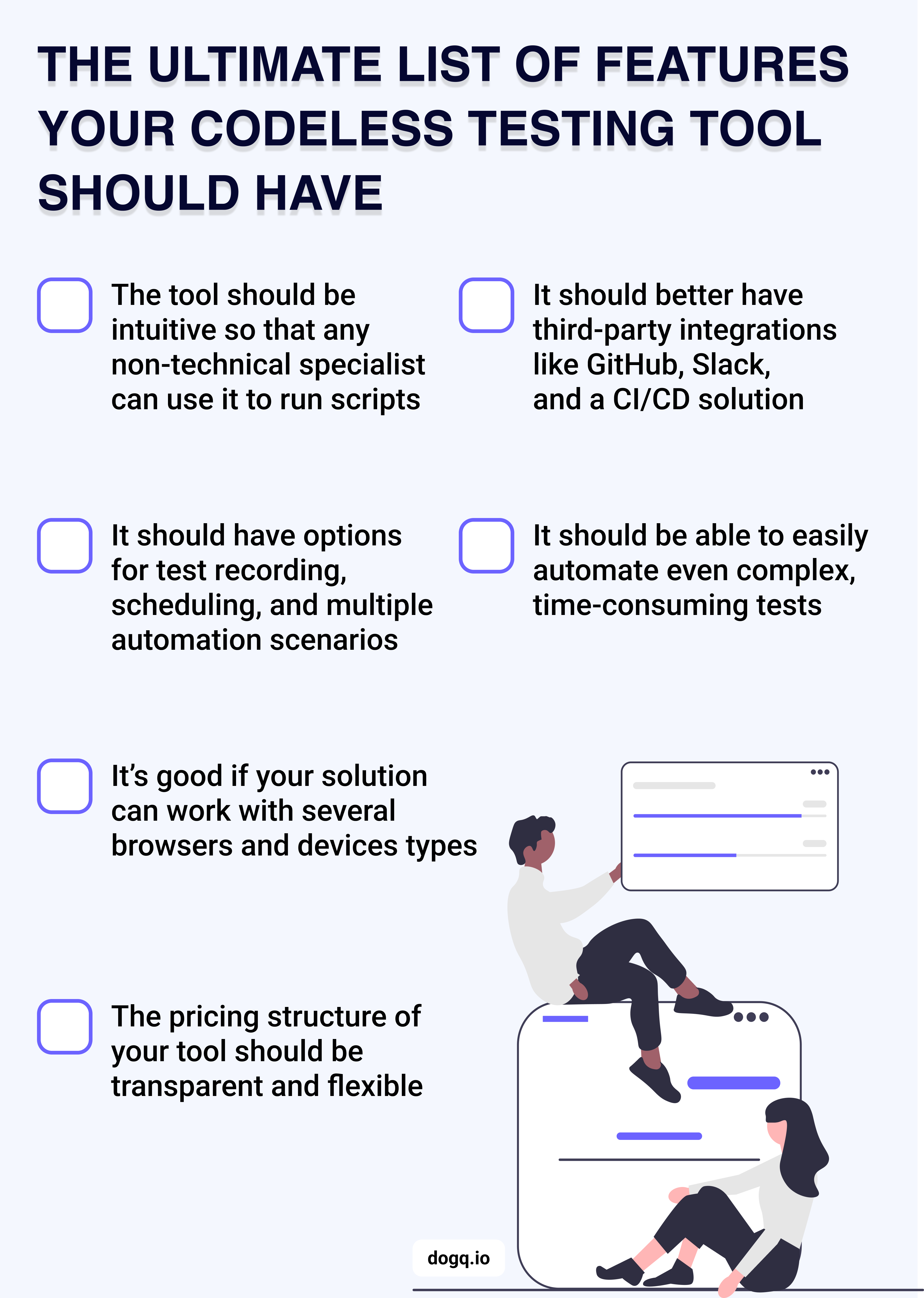
- The tool should be intuitive so that any non-technical specialist can use it to run scripts;
- It should be able to easily automate even complex, time-consuming tests;
- It should have options for test recording, scheduling, and multiple automation scenarios;
- It’s good if your solution can work with several browsers and devices types;
- It should better have third-party integrations like GitHub, Slack, and a CI/CD solution;
- The pricing structure of your tool should be transparent and flexible.
To make the choice easier, you can contact a DogQ team of software experts who can advise you on the best codeless test automation tools that will suit your business needs.
DogQ is a codeless testing tool that has all these features and is Selenium-based. This tool allows you to automate all the main test cases, including UI, e2e, regression, functional, and other types of web product testing.
The price for using DogQ will depend on the number of tests you need to perform for your web app. The first fourteen days with DogQ will be free. Then, the price will depend on the number of tests you need. If the needs of your venture are unique, DogQ will be glad to work out your individual pricing plan.
Remember what the incentive for automation testing was? Right, to save precious time. In the best tradition of automation testing, DogQ allows you to perform several parallel tests, has a feature of scheduled test runs, while all the reports are well-structured.
Should We Call It a Day?
It would be a blatant lie to say that automation testing is a cure-all. But as doctors say, everything that is resectable should be resected. In our case, everything that is automatable must be automated.
If you feel that you’re ready to enter a new era where testing doesn’t hinder the process of software development but becomes one of the pillars of continuous delivery; where you don’t need to organize a huge team of QA engineers to manually write test cases; and where testing is available to people who have never finished coding classes, contact us.
Together, we will choose the automation strategy and assist you with using DogQ – the easy to use codeless test automation tool.
